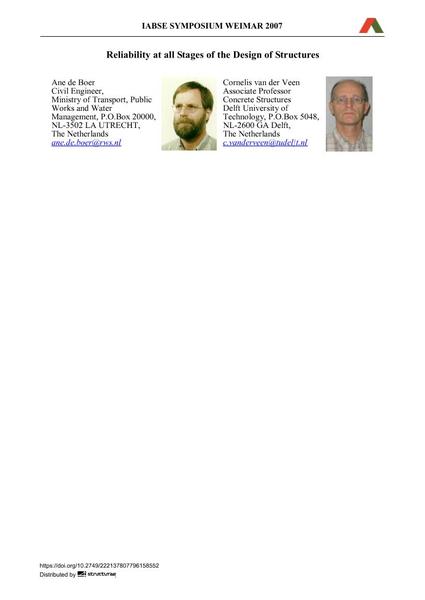Reliability and progressive collapse of structures

|
|
|||||||||||
Bibliografische Angaben
| Autor(en): |
Ane de Boer
Cornelis van der Veen |
||||
|---|---|---|---|---|---|
| Medium: | Tagungsbeitrag | ||||
| Sprache(n): | Englisch | ||||
| Tagung: | IABSE Symposium: Improving Infrastructure Worldwide, Weimar, Germany, 19-21 September 2007 | ||||
| Veröffentlicht in: | IABSE Symposium Weimar 2007 | ||||
|
|||||
| Seite(n): | 418-419 | ||||
| Anzahl der Seiten (im PDF): | 8 | ||||
| Jahr: | 2007 | ||||
| DOI: | 10.2749/222137807796158552 | ||||
| Abstrakt: |
The number of incidents of progressive collapse of structures has increased over the last decade. Design faults are becoming more frequent and the simple collapse of a structure during construction or in exploitation has become commonplace during the lifetime of a structure. Before the permit is granted to start the construction phase, the design has to be checked. In many European countries the technical review has been changed into a purely administrative process. The technical side of this process has become a process, which is covered by certified partners. The technical side seems to have become an administrative process not only during this permit phase of the structure but also during the construction phase of the structure. Meanwhile, the recent collapse of large halls and shops in Europe has changed the design thinking of engineers. A discussion is in progress and will lead to an acceptable solution for these processes. This discussion will probably lead to new rules or regulations and possibly new engineering schemes. The merging of different types of existing tools can minimise the number of new rules and regulations. In order to keep innovations on the agenda in the near future, the engineer must be free to design the structures of tomorrow. |
||||
| Stichwörter: |
Zuverlässigkeit Empfehlung Monitoring
|
||||
